 |
|
|
|
||
 |
||
Facts about the Sun • It is the center of our Solar System Diameter: 865,278 miles Composition: 92.1% Hydrogen, 7.8% Helium plus traces of all other elements Age: 4.6 billion years More facts at the bottom of this page.
Observing: NEVER observe the Sun with any optical device including cameras, binoculars or telescopes! Permanent eye damage will result with just a brief glimpse. Special filters that cover the optics of these devices must be used to safely observe the Sun. |
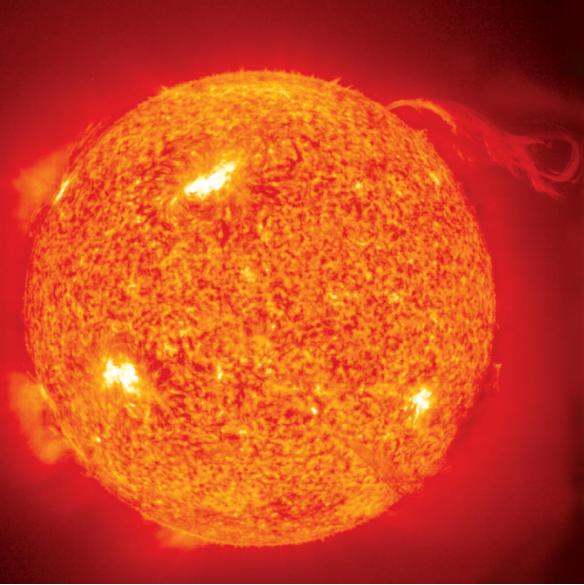 |
|||
THE SUN How often do we stop and think of the Sun when we think of the day? I think we take our days and nights for granted because they are natural, automatic cycles, like breathing. And, more importantly, how often do we think of the Sun when we think of life on Earth? The energy from the Sun is the reason that life developed and is sustained on Earth. Although the Sun is special to us, it is like all the other stars in the sky. Stars are created in a simple and natural process. They are the most common celestial object in the Universe. And, galaxies represent their abodes, where these fiery balls are congregated, where they are born, live and die. Nuclear Fusion and the Sun’s Life The Sun is about 4.6 billon years old and will last for another 5.5 billion years. Toward the end of its life, it will become a red giant with an outer atmosphere extending to about the orbit of Mercury. During its final days, the Sun will shed its outer layers in one final heave. Outwardly, this heave will produce a planetary nebula while the core shrinks inward to become a white dwarf, an object no bigger than the Earth but with significantly more mass and a high surface temperature. Structure of the Sun Interior Surface Sunspots are visible on the photosphere and are associated with strong magnetic fields that restrict the convection currents, creating cooler areas that appear darker against the brighter photosphere. Sunspots are about 6,300° F compared to an average surface temperature of 10,000° F. Immediately above the photosphere is a thin layer of gases about 2,000 miles thick called the chromosphere. The temperature there ranges from just 7,600° F near the photosphere to 14,800° F at its outer edge. Beyond the chromosphere is the corona, the most tenuous part of the Sun’s atmosphere. This rarified hydrogen gas reaches temperatures of up to 1,800,000° F and extends for millions of miles from the surface. The corona is visible during total solar eclipses as the irregular halo surrounding the Moon. Prominences (as pictured in the very top picture) are massive protrusions of ionized gas carried from the surface of the Sun into the corona. They usually protrude outward but sometimes loop back to the surface. Large prominences easily extend 10 to 30 Earth diameters from the photosphere. A flare is like a prominence but releases enormous amounts of energy and energetic particles into the Solar System, causing the aurorae on Earth as well as radio and communication disruptions. The Sun produces a solar wind made of highly ionized gas that permeates the Solar System. This gas can reach speeds up to 435 miles per second with a density varying from 160 to 1,600 particles per cubic inch. Additionally, sunlight itself exerts a small amount of pressure. Both the solar wind and radiating sunlight are responsible for pushing a comet’s tail away from the Sun.
There is only one safe way to view the Sun with a telescope, and that is to use a solar filter that completely covers the front of the telescope (the actual filter may be the same diameter as your telescope or could be smaller). All other types of filters or methods are dangerous! Solar filters can be purchased at your local telescope store or through retailers that advertise in the popular monthly astronomy magazines. DO NOT attempt to make your own filter. Solar filters transmit about 1⁄100,000 of the Sun’s light and filter out harmful rays. Once the filter is fastened securely to the front of the telescope, use the telescope in a normal fashion. Important: Remember to cover up your finderscope or reflex-sight finder — better yet, remove it! These also present viewing hazards and/or can be damaged by the Sun if they are not covered. To point the telescope at the Sun, let the telescope’s shadow be your guide. Move the telescope until the shadow of its tube is smallest. The Sun should then be in or near your eyepiece field of view if you are using a low magnification around 50x. The Sun emits so much energy that many of its features are overpowered by its brilliance. With a regular, white-light solar filter, only the photosphere and sunspots are visible. A special hydrogen-alpha filter is required to view prominences. Sunspots. Sunspots are plainly visible with a regular, white-light solar filter. They form, grow and dissipate, rotating with the Sun, changing their appearance daily. The inner and darkest part of a sunspot is called the umbra, while the surrounding lighter area is called the penumbra. Sunspots often appear in groups composed of many larger and smaller spots. There is an 11-year waxing and waning cycle of sunspot activity, however, the length of this cycle can vary by a few years. Prominences. In order to view prominences, telescopes must be fitted with a special hydrogen-alpha filter or you can buy a small telescope which incorporates a hydrogen-alpha filter. These start at around $600. Hydrogen-alpha filters transmit only a very narrow range of light on the red end of the spectrum where prominences are visible. Prominences cannot be seen with regular light-white solar filters because they get “washed out” among all the other colors that these filters transmit. Without a hydrogen-alpha filter, prominences can sometimes be seen around the edge of the Moon during a total solar eclipse. The hydrogen-alpha filter provides incredible views of the Sun. Not only will you see prominences, but you will also see the Sun’s mottled surface as well as the chromosphere. Changes in prominences occur hourly. I highly recommend making inquires at your local planetarium, club or telescope store about the possibility of observing the Sun through a hydrogen-alpha filter. |
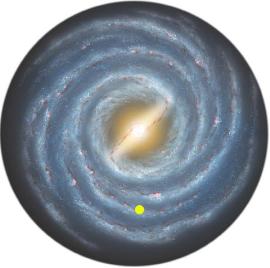 |
||||
An illustration of our Milky Way Galaxy showing the location of our Sun (the yellow circle). Our Sun is located in the Orion-Cygnus arm. Farther out from us is the Perseus arm and closer in is the Sagittarius arm. |
|||||
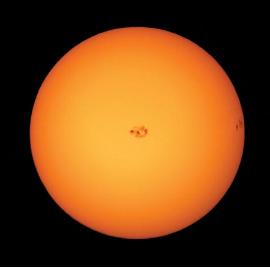 |
|||||
A large sunspot as it would appear through a white-light solar filter. |
|||||
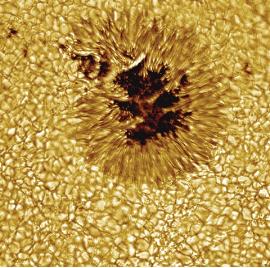 |
|||||
Close-up of a sunspot with a white-light filter. On a very “clear” day, it is possible to see detail close to what is shown in this picture. |
|||||
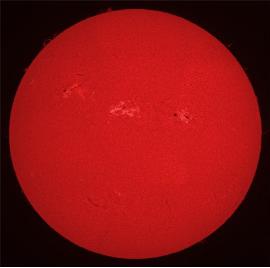 |
|||||
A typical picture of what the Sun looks like through a hydrogen-alpha filter. |
|||||
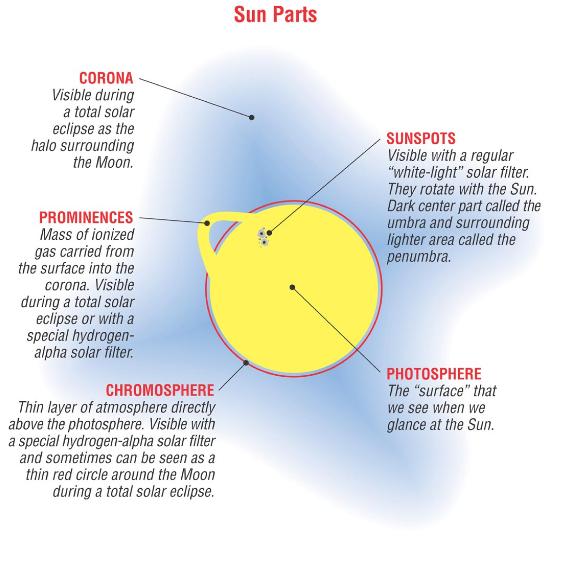 |
||
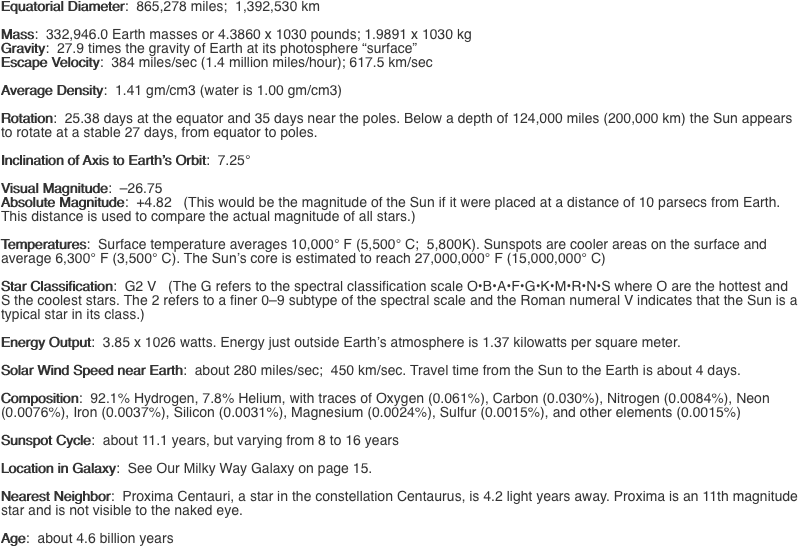 |
||
What’s Out Tonight? is sponsored by Ken Press, publisher of astronomy books and charts. |
||